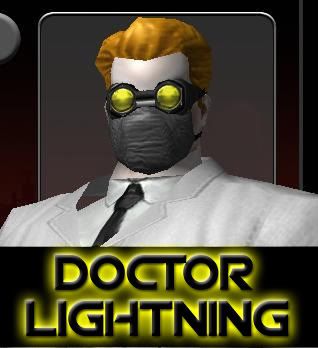
Attention America, this is Doctor Lightning broadcasting from under the Thames River in England. This transmission is about one of the few heroes I respect... The Manhunter.
_____________________________________
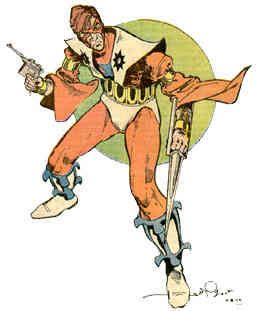
I've been a comic fan for many, many years (27 years in fact). Yes, even Doctor Lightning is fond of comics. My interests are wide and varied.
I got into them in the 80s when my godparents got me a box of 200 (100 Marvel, 100 DC)comics from JC Penny for Christmas. I was in the middle of the
Bronze Age of comics and I was loving it.
This was before Batman became an obsessed, misanthropic psychotic. This was when Spider-man didn't have more neuroses than Woody Allen. This was when the X-Men weren't whining about being ostracized by people. This was when Marvel heroes had real costumes and not fancy, trendy clothing worn by ravers in a shitty dance club. See the X-Men and Daredevil movies for example.
One comic in particular got me into DC and pulp style comics heavily. In 1984, DC published a collection of stories involving a character from the 1940s. He was
Paul Kirk and was a member of various hero groups during World War 2.

Unlike other non-superpowered heroes of the time (the
Punisher, Batman, S
hang-Chi etc), Paul Kirk really struck a chord in me. I don't know why, but something about his appearances in the Golden Age and Bronze Age really, really, REALLY left a deep
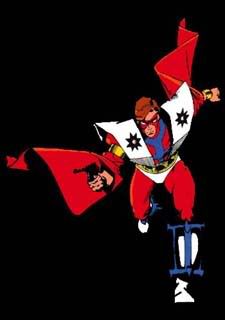
impression on me.
Kirk's unwavering sense of honor, justice, loyalty and deep intolerance of those who consistently manipulated others for their needs had a resonating effect on me. Those attributes were also evident in other pulp style heroes such as the Shadow, the Phantom, the Spirit, the Crimson Avenger to name a few.
A relentless, stalwart avenger who sought justice for those oppressed. So this is one of the heroes who's had a profound effect on me.
Take the time to read the following bits of information on Paul Kirk.
Taken from
Who's Who in the DC Universe...
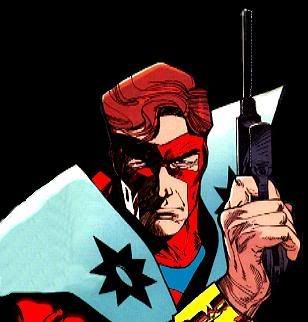 History
History.....As a young man, socialite Paul Kirk made a reputation as a big-game hunter and tracker in Africa. Boasting superior tracking skills, Kirk lead game safaris and captured animals for zoos around the world in the late 1930's. He tired of the life, seeking greater challenges. His abilites came to the notice of a group of alien hunters known as the
Manhunters, who track down criminals. Shortly after the United States entry into World War II, Kirk was tricked into joining the society of Manhunters by tracking down the murderer of his friend Police Inspector Donovan (himself a Manhunter Agent). Taking the name Manhunter and the costume as his own, Kirk had little contact with other Manhunter agents, including Dan Richards, also calling himself Manhunter.
..... As World War II progressed, Kirk began working for
OSS, an American Intellegence group, usually not in costume. Kirk undertook many brutal missions behind enemy lines, and by the time of the war's end, tired of the senseless brutality and took to Africa to try and heal the wounds his hunting had created on his soul.
.....In 1946, weary of living, Kirk was accidentily trampled by an elephant. Near death, his body was taken by a group called the Council, a eugenics group bent on world domination. Over the decades, Kirk's body was repaired and altered, giving him greater reflexes and the ability to heal wounds instantaneously. His genetic template was used in the groundforces of The Council, its soldiers were Kirk's clones. Learning of The Council's plans for world conquest, Kirk shattered The Council and destroyed much of its resurces. One of the clones became a hero of sorts, infiltrating the Darkseid lead Secret Society of Super-Villains and smashing its plans for a time, at the cost of his own life. All the other clones have been eliminated by friends of Paul Kirk.
Powers and Abilities.....Paul Kirk was one of the greatest trackers and hunters in modern history. Using these abilities, and with great fighting prowess, Paul Kirk was a relentless fighter for justice. Kirk was proficient with many types of firearms and vehicles.
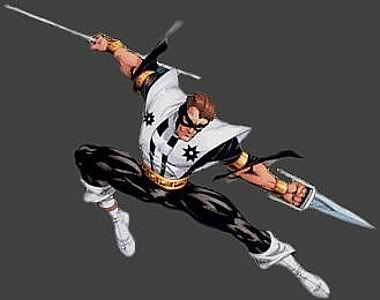
Taken from the Wiki entry on him...
The following month after Dan Richards appeared, DC decided to have one of their pre-existing characters, big game hunter Paul Kirk, put on a costume and take the name Manhunter as well. This happened in April 1942's Adventure Comics #73, written by Jack Kirby and drawn by Kirby and Joe Simon, although Paul Kirk had first appeared in Adventure #58. Kirk was a wealthy hunter who lost a friend to a murderer, and decided to hunt a more dangerous quarry: outlaws.
Although Richards and Kirk never met in golden age stories, they did meet in All-Star Squadron #31, from 1984, and argued over who should get the Manhunter name. They resolved the dilemma by joining different teams: Dan Richards became a member of the Freedom Fighters, while Paul Kirk stayed as a member of the All-Star Squadron.
Paul Kirk appeared in Adventure Comics from issue #73 to #92, which appeared to end his career in 1944, but it was not to be. Many years later, in 1973's Detective Comics #437, Paul Kirk was literally resurrected in a story by Archie Goodwin and Walt Simonson. He had been killed by an elephant on safari in the 1940s, but his body had been saved by the Council, a secret society dedicated to the control of the world. After his return from death, Kirk had a healing factor (it was later revealed that this was due to an injection of nanobots) and was trained extensively in the martial arts by Asano Nitobe. He was also the genetic source for many clones, which the council intended to use as their paramilitary arm, with the original Paul Kirk as their leader.
The Council underestimated Kirk's morals, though, and when he refused to kill a police officer, they realized he couldn't be their assassin and decided to have him terminated.
In a classic series of short vignettes and a single issue crossover with Batman, Manhunter defeated the Council, but not before they managed to kill him. Interpol agent Christine St. Clair and Nitobe believed that all the clones were killed, but swore to kill any they found in the future.
Paul Kirk's story ran from Detective Comics #437 through #442 as a backup, and #443 (1974) was the aforementioned full-length crossover with Batman. These stories are considered as classics of the comic-book form and have been reprinted several times; first, in 1979 and in black and white format by Excalibur, and then in color by DC in 1984. The Simonson/Goodwin Manhunter was reissued again in 1999, with some additional material (namely, a silent story illustrated by Simonson from notes by Goodwin, who had died prior to the issue of the new collection; as such, the new collection was dedicated to Goodwin's memory).________________________________________________________
Now, as to why Kate Spencer is pitiful. Well for one thing, the Manhunter we all know and love is about hunting his enemies and dispatching them. He uses his skills as a big game hunter to track his enemies in the dead of night. His deductive reasoning is on par with Batman, the Sandman (Wesley Dodds and his protegé), the Elongated Man and the Shadow. His tenacity, nay... His obsession to capturing evil doers is legendary. But above all, he's a man of justice.
Later another Manhunter (Mark Shaw) would carry on the tradition, albeit for profit. But his thirst for justice sometimes overcame his need for money. In the end, he's still a Manhunter.
Kate Spencer on the other hand... Just another silly angry "femme fatale" with big guns. Her gear... Well, here. Read this.
When Kate pursues Copperhead, she sneaks into an evidence room to steal some items she can use against him. Manhunter #15 tells the origin of each of the three items she takes:
- The Suit - The suit comes from a member of the Darkstars who died in battle and fell to Earth to rot. A drifter found it and used it to defend himself against a group of attackers. Successfully defeating them, he robbed them and left the suit in a dumpster.
- The Gauntlets - A small-time crook found the gauntlets, originally worn by Azrael during his stint as Batman, in Gotham City. The crook used them in an unsuccessful burglary, but when the police arrived, the crook fell to his death, leaving the gauntlets still dug into the side of the building.
- The Staff - An attack on Eclipso ended with several heroes dead; among them was a man programmed to believe that he is Mark Shaw. The staff was recovered with the body and hidden in storage.
So she steals equipment and calls herself the new Manhunter? Such a slap to the face of what is the noble tradition of the Manhunter. There will be a reckoning and this impostor to the name will get her comeuppance soon.
This is Doctor Lightning signing off...

 What if you experienced a personal tragedy that left you with no beliefs to cling to?
What if you experienced a personal tragedy that left you with no beliefs to cling to? Then, all hell - as they say - breaks loose...
Then, all hell - as they say - breaks loose... 




















